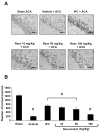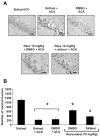Resveratrol pretreatment protects rat brain from cerebral ischemic damage via a sirtuin 1-uncoupling protein 2 pathway
- PMID: 19356683
- PMCID: PMC2668125
- DOI: 10.1016/j.neuroscience.2009.01.017
Resveratrol pretreatment protects rat brain from cerebral ischemic damage via a sirtuin 1-uncoupling protein 2 pathway
Abstract
Resveratrol is a natural polyphenol found in grapes and wine and has been associated with protective effects against cardiovascular diseases. In vitro, both resveratrol preconditioning (RPC) and ischemic preconditioning (IPC) require activation of sirtuin 1 (SIRT1), a nicotinamide adenine dinucleotide (NAD(+))-dependent deacetylase, to induce neuroprotection against cerebral ischemia. In the present study, we tested two hypotheses: (a) that neuroprotection against cerebral ischemia can be induced by RPC in vivo; and (b) that RPC neuroprotection involves alterations in mitochondrial function via the SIRT1 target mitochondrial uncoupling protein 2 (UCP2). IPC was induced by 2 min of global ischemia (temporary bilateral carotid artery occlusion with hypotension), and RPC, by i.p. injection of resveratrol at 10, 50 and 100 mg/kg dosages. Forty-eight hours later, we compared the neuroprotective efficacy of RPC and IPC in vulnerable cornu ammonis 1 hippocampal pyramidal neurons using a rat model of asphyxial cardiac arrest (ACA). SIRT1 activity was measured using a SIRT1-specific fluorescent enzyme activity assay. In hippocampal mitochondria isolated 48 h after IPC or RPC, we measured UCP2 levels, membrane potential, respiration, and the mitochondrial ATP synthesis efficiency (ADP/O ratio). Both IPC and RPC induced tolerance against brain injury induced by cardiac arrest in this in vivo model. IPC increased SIRT1 activity at 48 h, while RPC increased SIRT1 activity at 1 h but not 48 h after treatment in hippocampus. Resveratrol significantly decreased UCP2 levels by 35% compared to sham-treated rats. The SIRT1-specific inhibitor sirtinol abolished the neuroprotection afforded by RPC and the decrease in UCP2 levels. Finally, RPC significantly increased the ADP/O ratio in hippocampal mitochondria reflecting enhanced ATP synthesis efficiency. In conclusion, in vivo resveratrol pretreatment confers neuroprotection similar to IPC via the SIRT1-UCP2 pathway.
Figures







References
-
- Arsenijevic D, Onuma H, Pecqueur C, Raimbault S, Manning BS, Miroux B, Couplan E, Alves-Guerra MC, Goubern M, Surwit R, Bouillaud F, Richard D, Collins S, Ricquier D. Disruption of the uncoupling protein-2 gene in mice reveals a role in immunity and reactive oxygen species production. Nat Genet. 2000;26:435–439. - PubMed
-
- Bodyak N, Rigor DL, Chen YS, Han Y, Bisping E, Pu WT, Kang PM. Uncoupling protein 2 modulates cell viability in adult rat cardiomyocytes. Am J Physiol Heart Circ Physiol. 2007;293:829–835. - PubMed
-
- Borra MT, Smith BC, Denu JM. Mechanism of human SIRT1 activation by resveratrol. J Biol Chem. 2005;280:17187–17195. - PubMed
-
- Bradford MM. A rapid and sensitive method for the quantitation of microgram quantities of protein utilizing the principle of protein-dye binding. Anal Biochem. 1976;72:248–254. - PubMed
Publication types
MeSH terms
Substances
Grants and funding
LinkOut - more resources
Full Text Sources
Other Literature Sources
Molecular Biology Databases

